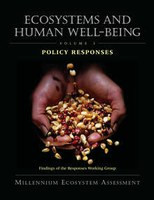1.3.2 Existing ecosystem services frameworks

The Millennium Ecosystem Assessment
The conceptual framework of the Millennium Ecosystem Assessment places human well-being as the central focus for assessment while recognizing that biodiversity and ecosystems also have intrinsic value and that people take decisions concerning ecosystems based on considerations of both well-being and intrinsic value.
 The first reference framework for Ecosystem Services Assessment has been produced through the Millennium Ecosystem Assessment (MEA) commissioned by the United Nations at the beginning of the year 2000. The study carried out by 1300 scientists from around the world ended in 2005 [MEA, 2005; MEA, 2003
The first reference framework for Ecosystem Services Assessment has been produced through the Millennium Ecosystem Assessment (MEA) commissioned by the United Nations at the beginning of the year 2000. The study carried out by 1300 scientists from around the world ended in 2005 [MEA, 2005; MEA, 2003 ].
].
The Millennium Ecosystem Assessment conceptual framework assumes that a dynamic interaction exists between people and ecosystems, with the changing human condition serving to both directly and indirectly drive change in ecosystems and with changes in ecosystems causing changes in human well-being.
The Millennium Ecosystem Assessment framework is presented with recommendations regarding the importance of multi-scale and multicriteria approaches, the consideration of multidimensional aspects of decision-making, but also the integration of various forms of knowledge and the participation of stakeholders due to the effect of any assessment on their relative power or perception.
However, the general framework points de facto most of the attention to economic valuation, by emphasizing the links between ecosystem services and human well-being through the value of the ecosystem and the links between human drivers of changes to ecosystem services though the costs of preservation or the losses of benefits.
The Economics of Ecosystems and Biodiversity
 Following initiatives such as the Stern Review on the Economics of Climate Change [Stern, 2006
Following initiatives such as the Stern Review on the Economics of Climate Change [Stern, 2006 ] and the Cost of Policy Inaction study initiated by the European Commission [Braat and ten Brink, 2008], the Economics of Ecosystems and Biodiversity (TEEB) initiative intended to bring ecosystem services in the policy arena with a clear economic connotation [Braat and De Groot, 2012
] and the Cost of Policy Inaction study initiated by the European Commission [Braat and ten Brink, 2008], the Economics of Ecosystems and Biodiversity (TEEB) initiative intended to bring ecosystem services in the policy arena with a clear economic connotation [Braat and De Groot, 2012 ].
].
Basically, the TEEB framework is an extension of the so-called cascade model published by Haines-Young and Potschin [2009 ], which is based on a “unidirectional downward flow” from ecological functions to ecosystem services and human well-being.
], which is based on a “unidirectional downward flow” from ecological functions to ecosystem services and human well-being.
The TEEB framework added positive feed-backs via institutions, judgments, management and restoration.
The TEEB provided a two-steps approach for Ecosystem Services Assessment in support of decision-making: first identify and assess ecosystem services, mostly based on changes in ecosystem services values related to land-cover changes, and second estimate and demonstrate the value of ecosystem services. This second step aims at revealing the full costs and benefits of ecosystem uses and at promoting economic mechanisms that incorporate the values of ecosystems into decision-making, through incentives and price signals.

